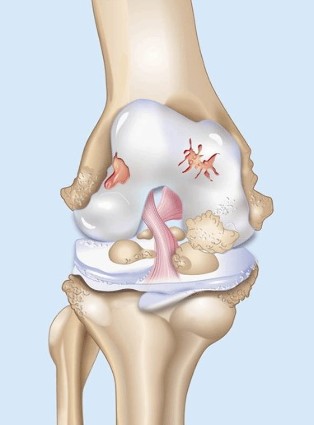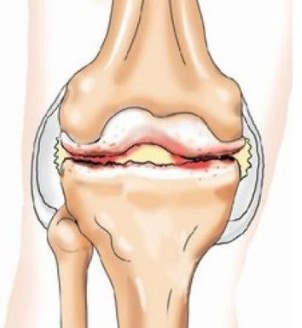Deforming gonarthrosis (knee osteoarthritis) – a disease in the hyaline knee cartilage due to inflammatory degenerative-dystrophic process. This disease encompasses tibial condyle and the femur.
Arthrosis of the knee joint develops slowly. The primary symptoms of this ailment is pain and stiffness. This kind of arthritis, like osteoarthritis, is most common in comparison with other types (arthrosis of phalanges, hip arthrosis, elbow or shoulder arthrosis).
This disease manifests itself most often in middle-age (40-45 years), predominantly in women. The cause of osteoarthritis in young people can serve any serious injury or heavy load (e.g. athletes).

The causes of osteoarthritis of the knee
The cause of deforming arthrosis of the joints can not be, and usually is the totality of the circumstances and of many catalytic factors that will eventually lead to the development of the disease. In medicine, the causes of osteoarthritis are divided into:
- primary;
- secondary.
Primary osteoarthritis develops in older people due to natural aging (erase) the cartilage tissues of the body in conjunction with the accompanying complications. Among the complications include problems such as:
- hereditary pathology;
- enhanced stress on the joints throughout life;
- obesity (in 10% of cases).
Deformavit to secondary arthrosis will take 30% of all cases of the disease in the knee iuncturam. This form of osteoarthritis develops as a result of various injuries:
- damage to the meniscus;
- fracture of the tibia;
- the torn ligaments;
- bruise and pain in the kneecap.
Symptoms of secondary osteoarthritis appears very late – after 3-4 years, however, serious injuries symptoms of the disease appear after 3-4 months.
At risk for the development of gonarthrosis includes people who after 40 years are beginning to engage in sports or other physical activity. Running, squats or push-UPS give extra work worn joints with age. Such studies could lead to rapid development of degenerative and dystrophic processes in the joints.
There are cases of development of osteoarthritis on the basis of existing patient comorbidities:
- Bechterew's disease;
- rheumatoid, psoriatic or reactive arthritis;
- gout;
- varicose veins;
- excess weight (obesity).
The reasons for the development of deforming arthrosis directly into the knee joint include:
- regular heavy physical exertion;
- lifting weights;
- frequent climbing of stairs;
- professional sports;
The risk to be diagnosed as gonarthrosis, increases if the patient is found injuries to the spinal division of the bones, various neurological diseases, metabolic disorders, diabetes mellitus (3-5%) genetic predisposition due to the weakness of the ligamentous apparatus.
Often (50-60%) the development of deforming arthrosis of the knee joint is due to muscle spasm anterior surface of the thigh. Such spasm is not evident until the occurrence of pain in the knees. Inconveniences are mild pain in the lower back, heavy legs and fatigue.
If the iliac-lumbar straight and thigh muscle are in a constant state of spasm, with age, the patient will develop "contraction" of the knees, which will significantly limit the motor function.
The latest discovery scientists
Belgian orthopedic surgeons from the city of Leuven have recently found a previously unknown and absolutely not studied a bunch of ALL, which is localized in the human knee. This bundle was named "front-side" or "anterolaterala".
The study, which lasted for 4 years, have been confirmed in rare cases, when patients after successful surgery for torn ligaments or knee injuries, pain during exercise did not disappear, and the observed instability of the knee joint.
The research was conducted by experts from 40 patients, which allowed to detect the bunch, which the doctors had no data at all. As it turned out, the main function of ligaments are anterolaterala rotational motion of tibial bones.
When injury knee doctors were not even aware of the necessity of its correction during surgery.
Classification of deforming arthrosis of the knee joint
Often the disease develops in only one knee. Given the intensity of development of pathological processes, physicians allocate 3 degrees of osteoarthritis:
- The first degree of knee osteoarthritis does not entail deformavit changes, however, are characterized by recurrent pain after load on the joint. Sometimes showing a slight swelling of the joint, disappearing on their own.
- When a knee in the second degree, the symptoms of the disease is increasing considerably. Pain syndrome is seen after a small exercise. Walking, lifting weights cause prolonged and intense pain, the patient has a characteristic knee crunch. Probably the appearance of easy deformation of the joint and slight limitation of motion.
- In the third degree of deforming arthrosis of the knee joint there is maximum disclosure of the symptoms of the disease. The patient is disturbed gait, pronounced deformity of the joint and significant functional limitation of movements. Pain is worse depending on weather conditions, limited joint reaches its maximum point. The pain is so severe that the patient cannot find a position in which she fell, disturbed sleep.

What can confuse osteoarthritis of the knee articulation?
There are several diseases with similar symptoms of knee osteoarthritis:
Blockade of the knee joint and the blockade of the meniscus. This disease develops rapidly. With a sharp movement there is a crunch in the knee accompanied by a sharp pain that goes through 10-15 minutes. A day later the swelling is formed of the patella.
Different types of arthritis (rheumatoid, psoriatic, reactive), articular rheumatism, ankylosing spondylitis, gout. To distinguish these diseases from osteoarthritis with the help of blood test.
Inflammation of the tendons of the knee. This disease affects mostly women after the age of 40. Pain occur when lifting or descending the stairs. The pain covers the inner surface of the knee, but the functionality of the joint is not limited.
Vascular pain in the knee joints. It is symmetric involvement of joints, covering both knees at the same time. It occurs mostly in young generation because of accelerated bone growth. Pain syndrome says:
- with the change of weather conditions;
- colds;
- during exercise.
Is defined as a nagging pain (twisting).
Symptoms of deforming knee arthrosis in stages
In the first stage the affected knee joint by their appearance differs nothing from the healthy.
- Sometimes in the area of injury you may notice mild swelling.
- In rare cases, iuncturam observed build-up of fluid, it swells, taking a spherical shape.
- Synovitis develops.
- Restricted to the functionality of the joint.
- There is a sense of gravity.
What is the reason?
At the initial stage of the development of arthrosis in the joint is a violation of the small intra-bone vessels and blood circulation in General, which depends on the nutrition of hyaline cartilage.
With further development of the disease (second stage) the symptoms intensified. Pain is defined in the anterior-internal side of the articulation and worried even at high loads, retreating to rest and going back at the slightest movement.
When deforming arthrosis of the knee joint of the third degree there is a significant deformation of the articular bones. They pressed into each other, cartilage is almost destroyed, the limited functionality is enhanced. Syndrome pain recedes for a moment, regardless of the tension or relaxed state in which the joint. Flexion and extension of the limb is difficult.
The joint is severely deformed, his legs are bent at the O - or X - shaped, gait becomes unstable. Quite often the patient had to walk with crutches or canes.

































